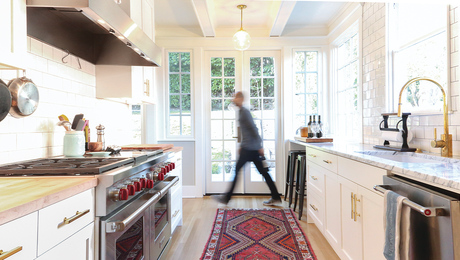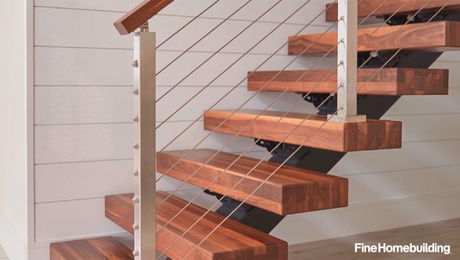Just saw a neighbor’s sub panel that was replaced replaced earlier this year from fuse to breaker(located in a closet, of course). The wire was aluminum. Isn’t aluminum only allowed from supply to main panel? Or is my mind getting more foggy?
Can I bet Bob answers first?


















Replies
AL wire can be used anyplace that where the terminals are rated for it.
And the code still allows al wiring in #12 (15 amp) and #10 (20). But I don't know if anyone makes it.
But for replacement purposes you can get COALR (sp?) devices, but expsive.
Most pannel lugs and larger breakers are rated both CU and AL.
Bascially AL is used any place that larger currents ratings are needed which would mean large $$$ CU or one size larger, but much cheaper AL.
.
A-holes. Hey every group has to have one. And I have been elected to be the one. I should make that my tagline.
thanks...
I wrote "Bob" when I was thinking of you...
I'm ashamed, but I was right about who would answer 1st...kinda
Edited 8/10/2008 5:16 pm by migraine
I hope you don't make the same type of mistake when talking to your wife <G>.Or is that how you got the handle - migraine -?.
.
A-holes. Hey every group has to have one. And I have been elected to be the one. I should make that my tagline.
I hop I don't call her "Bob"
I don't want to try and explain THAT one!
I used make them when introducing girlfriends.
I'd been dating this little, (5-1, 105-lbs), redheaded gal for about two months, and my best friend and his girlfriend were home from college for Christmas break.
They dropped by my place to say hi, on what happened to be Sunday morning of the first weekend the girlfriend stayed over.
I know I'm bad with names so I said her name to myself three times, to make sure I remembered it. And, of course forgot it in the middle of introducing her. "John, Vicki, Lulu, this is uhh, is uhh, is uhh."
At the third uhh, she quite rightfully took umbrage and landed a right on my jaw, which took me to the floor. I came to: she was gone, and John was laughing so hard he was crying. I was a pretty rough and tumble guy back then, and got in more than a few fights. She is the only person to ever knock me out. John, whose dad coached golden gloves, said it was the best right he had ever seen.
OH, and her name was Sharon.
I'm not sure ow Bill feels about it, but I'll take it as a compliment <G>In my area, multistrand alum >20A (usually >=40A)is common and accepted.
Remember Mary Dyer, a Christian Martyr (Thank you, Puritans) http://en.wikipedia.org/wiki/Mary_DyerMay your whole life become a response to the truth that you've always been loved, you are loved and you always will be loved" Rob Bell, Nooma, "Bullhorn"
AFAIK, aluminum wire is no longer made in sizes smaller than #6. Co/Alr receptacles recently cost me about $2.75 each, with a similar price for the switches. There are no GFCI's rated for aluminum. The aluminum wire makers have been pushing their product a lot lately, and I have seen some guys use it for range circuits, etc., that are dedicated circuits of larger amperages. I will admit that the wire is a lot easier to handle. There remains the issue of connecting wires. The purple Ideal wire nuts are -according to Ideal - supposedly for 'temporary' connections. Thomas & Betts has some nuts rated for use by our Canadian neighbors. The connectors made by King are rather large, and cost about $3 each. Rated crimp(Copalum) are simply not an option.
I did not know what the limit was on the smaller sizes.I see a number of older range installation that used AL SE wire. That was the old 3 wire supplies..
.
A-holes. Hey every group has to have one. And I have been elected to be the one. I should make that my tagline.
I had a subpanel installed in a workshop I was building last year. I tried to get copper wiring to run, but the electrician checked around & couldn't find a single supplier that stocked copper in the larger sizes around here.
Aluminum is becoming more popular these days. Its the only thing I see for commercial services anymore. Hope they used the NoLox. You will know if you see black goop all over the terminations. It is Code.
No use of anything(nolox), But I did notice that.
Yes(if anyone questions) they were licensed electricians
I'd get a picture but not enough room in the bedroom closet(hint,hint) to get a photo.
They led her to believe that they took care of all the electrical issues. yeh, right...
You may have a local code that requires anti oxidant paste but it is not in the NEC.
You could be right. But you had better use it anyways. I have seen the consequences, and they are not good.
I was going to ask that, I thought it was primarily where you had dissimilar metals. Agree that it is a good idea but I am always very skeptical of "it's code" without a cite.For those who have fought for it Freedom has a flavor the protected will never know.
It is pretty hard to find a lug that is "dissimilar" to aluminum wire. Most big lugs are aluminum. If that was the issue you would need the goo on copper wire.
In fact there is testing that shows aluminum wire performs slightly better than copper in the aluminum lugs that are so common on big breakers and terminations. It is still not a significant difference.
The biggest change in the CO/ALr device is the binding screw. They use a brass alloy that more closely tracks the expansion rate of aluminum than he regular steel screw.
If you use aluminum, be sure you carry a torque wrench! There is anecdotal evidence that most failures involved improperly torqued terminals. Too tight can be as bad as too loose. You damage the threads and they can slip. That is more important than the goo.